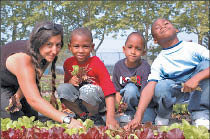 |
|
Reaping what they sow: Chapman and boys on the Brooklyn farm. |
Farm Educator
Added Value/Food Change
Brooklyn, N.Y.(718) 855-5531
Age: 27
Salary: $40,000.
About the Organizations: Added Value owns a farm in the Red Hook neighborhood of Brooklyn, where it provides local youth with leadership experience and nutrition education through cultivating and selling organic farm products. FoodChange runs food-related services for low-income families, such as helping school and after-school programs deliver a curriculum called CookShop to increase youth awareness and consumption of wholesome foods.
Her Job: Chapman is the link between the two organizations through a pilot program called Farm to Classroom. She teaches the CookShop curriculum in four first-grade classes at a Red Hook elementary school on behalf of Food Change, and works with those youth at growing and selling crops at the Added Value Farm.
“We spend the fall out in the farm, where we learn the basics about what a plant needs to grow, and come wintertime we are in the classroom. We don our scientist caps and delve into some pretty serious plant biology, in a totally first-grader way.”
Best Part: “The dynamic nature of the job. I get to work with plants and all sorts of folks. It’s the plants that bring us together. I have about 80 seven-year-olds in four classes! Plus, the farm is like a real place of community. Seniors come from the local senior center to help out.”
Worst Part of the Job: Because Farm to Classroom is a pilot program, its reach is limited. “We want to move really intentionally in terms of development. We have to say ‘no’ a lot to additional classes, teachers and kids at this point, and that’s hard. It’s tough to be approached by a group of third-graders saying, ‘Why don’t you come to my class?’ It’s a heartbreaker.”
The Need: “Most of my kids start the year thinking a carrot’s place of conception is the grocery store. It’s important to know where one’s food comes from in order to make healthy eating decisions. That knowledge is empowering; doing meaningful work is empowering for these kids.”
Memorable Moment: “Last year, at the end of the year, I was transporting some local chickens to the farm because we don’t keep animals on the Added Value farm. I was walking with one of my students over to the chickens and we were talking about how to handle them safely. Then he stopped dead in his tracks and started saying over and over again, ‘Chicken is chicken.’
“I wondered what he was talking about as he repeated himself, but then I realized what he was connecting. It suddenly occurred to him that the stuff that he calls chicken on a plate comes from the animal that he saw in front of him. It was such a profound revelation for him, and I couldn’t help but think of it as part of the growing that he had done throughout the year, connecting all these plants and vegetables to food.”
Science Activities: Youths learn about the functions of a plant stem, for instance, “by taking celery stalks and sticking them in food coloring and watching them over two weeks to discover that stems are elevators for water.” Recently, “the kids have been growing broccoli under glow-lab lights that they will be carrying to the farm to plant.”
Kids’ Motivation: “They have great incentive to learn about how plants and their parts function because they have spent the fall outside on the farm and they are learning about their food.” They come to see that “plant foods are plants’ parts, like how lettuce is a leaf and that corn kernels are seeds. So there is a real vested interest in learning how plant parts work and grow because they want to be successful” at the farm.
– Alexis Vaughan
























